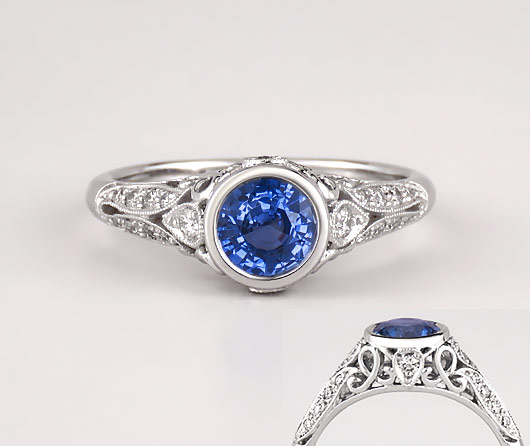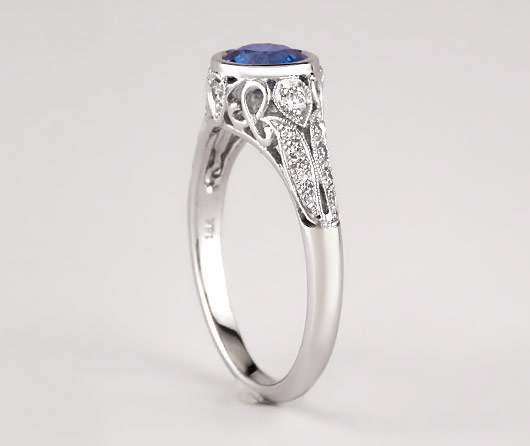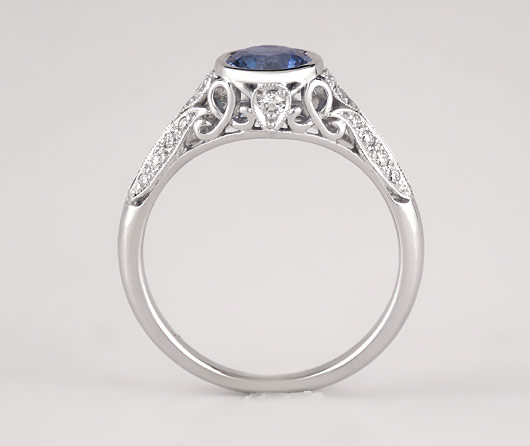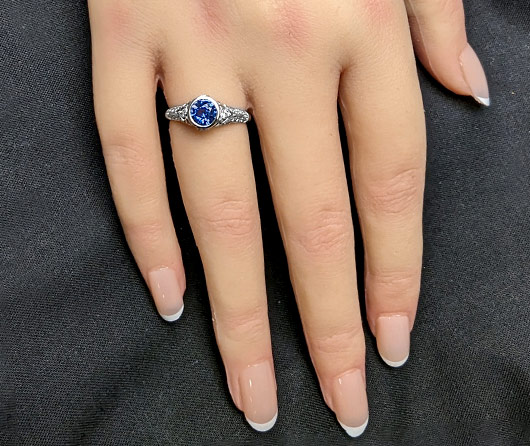

Ring Details
Ring Sizing & Delivery Time – The majority of our rings are size 6.5 to start. Remarkably, this size fits 30% of all women. If you would like this ring made to a specific size, we generally ship within one week of your order. Click here to see how long we are currently taking to size a ring.
When you checkout online, we provide a real-time expected delivery date. Because of the value, and that you must sign for the package, we will call or email you when we are ready to ship to ensure a smooth delivery.
If You Need the Ring Faster – simply select in the finger size selection box “No Sizing Yet, Ship Right Away”. We will ship the ring in its present size. You will have your new ring in a few days, boxed, bowed and ready for presentation.
After receiving your ring, if you find it needs additional adjustment, give us a call and we will mail you a special free set of ring sizers and a prepaid return label to send the ring back to us for final sizing. Read more about ring sizing.
Royal Kensington Blue Sapphire & Diamond Ring
Style #:
G4559
Jewelers are obsessed with diamonds. Jewelers are like crazy people when it comes to little diamonds. Because of their neutrality, they are perfectly white, so they don’t interfere with colored gems. Their brilliance is dazzling. Each diamond has 58 tiny facets polished onto the surface designed to catch and reflect the light. So, in this ring with 20 small diamonds, there are over 1,000 tiny mirrors and windows designed to capture and reflect light. The result, set in white gold, they glitter across the lacy surface.
Evening arrives, and you’re ready to go out on London town. Your little diamonds will dance the night away. You could even have attended one of the Royal Balls in London, knowing your ring would be right at home.
Our ring is called the “Royal Kensington”. It’s one of the finest rings in our London Royal Collection. The lacework detail looks like the detail on a Royal Coronation coach pulled by eight white horses.
Why We Love This Ring
The Kensington ring was made by two extraordinary brothers duplicating a type of jewelry style that was the rage from 1910-1930. Here is what we know: while they did exquisite work 100 years ago, the brothers are better. Acquire this ring, and you will have a piece jewelers will admire for the next 100 years, and you will have a lifelong love affair with your new ring.
Ring Details
Ring Sizing & Delivery Time – The majority of our rings are size 6.5 to start. Remarkably, this size fits 30% of all women. If you would like this ring made to a specific size, we generally ship within one week of your order. Click here to see how long we are currently taking to size a ring.
When you checkout online, we provide a real-time expected delivery date. Because of the value, and that you must sign for the package, we will call or email you when we are ready to ship to ensure a smooth delivery.
If You Need the Ring Faster – simply select in the finger size selection box “No Sizing Yet, Ship Right Away”. We will ship the ring in its present size. You will have your new ring in a few days, boxed, bowed and ready for presentation.
After receiving your ring, if you find it needs additional adjustment, give us a call and we will mail you a special free set of ring sizers and a prepaid return label to send the ring back to us for final sizing. Read more about ring sizing.
1-800-433-2988 | Monday - Friday 9:30 am to 5:00 pm, EST
Orders Over $1,000 require a signature on delivery. You may choose free FedEx Overnight or US Post Office Express Mail.
Orders Under $1,000 no signature is required. You may choose FedEx 2-Day Service or US Post Office Priority Mail.
Rings that need to be sized take extra time (See our current sizing time). If ordering a ring, you may select, “No Sizing Yet, Ship Right Away”.
Curbside Pickup is also Available – please give us a call to place your order.
Free Shipping Details
Shipping Details
Orders Over $1,000 – Ship Free by your choice of FedEx Overnight or US Post Office Express. A signature is required on delivery.
Orders Under $1,000– Ship Free by your choice of 2-Day FedEx or US Post Office Priority Mail. No signature required.
30-Day Returns/Exchanges
We design, craft, and create really nice jewelry with amazing gems. Our guarantee, she’ll love your gift. If for any reason she doesn’t… you know you’ve got 30-days for a refund or exchange.



